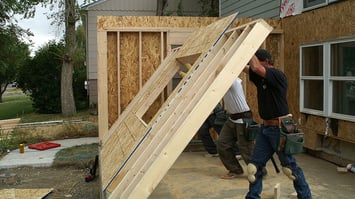
For many homeowners that need extra space—a spare bedroom, a bigger kitchen, a sunroom, or a larger living space—home additions are worth considering. In some cases, it’s certainly easier than purchasing or building a new home, when you consider the time and money involved. And now that housing prices are on the rise, this is doubly true. Rather than paying a premium for a larger home, many homeowners will be looking to add on to existing homes.
As a contractor, you’ll probably start seeing more and more of these requests from clients. It’s important to be prepared, have an efficient process in place and take time to consider what tools and fasteners you will need for that particular job. For example, for your framing and general construction needs, SCRAIL® fasteners are by far the best choice. They fire quickly and easily just like nails, plus you can adjust them and remove them as you would with screws, making It the most efficient fastener for any project! To help you prepare for home addition work, we’ve explored several factors you’ll want to consider before you begin.
Factor for Extra Design Time
One of the biggest things you’ll need to remember about home additions is that they allow homeowners to be highly creative—and for contractors, that means more time spent on the design phases of the project. It’s not as simple as building a deck or a backyard shed. Homeowners will be looking to make the most of their space and their investment, while also working to create something that fits available yard space and that works with the existing home.
Expect plans to go through multiple revisions before work gets underway and expect to work with an architect to get those plans approved prior to construction.
Consider the Work Done Before
Keep in mind that home additions are an entirely different beast from building a new home. When you’re creating an addition, you’re working with the specifications that the home’s original designer implemented. Depending on when the home was built, that could mean any number of things. In century homes and older homes, you could encounter things like plaster, which will require a specialized set of skills to recreate. More modern homes are likely stick-built, but on occasion, you may find metal framing or another oddity that you don’t often work with. Be prepared to be flexible since you’ll encounter homes and building methods of all kinds.
Working with Homeowners in Unusual Ways
You’ll also want to consider that the homeowners will most likely still be living in the home while you’re doing the work—and that can lead to lots of extra considerations.
By and large, homeowners should be prepared for the realities of a home addition, which can mean weeks of work, a lot of mess, and areas of the home that are inaccessible or unusable during construction. But the actual reality is, that many homeowners may think themselves prepared—and then find themselves growing frustrated with the process after the first week.
To help minimize frustration:
- Be clear at the outset about what to expect. Make sure the time frame is transparent, inform homeowners that water and electricity may need to be shut off at certain points to do parts of the job, and be clear about which areas will be unusable throughout the project.
- Take extra measures to preserve the livable parts of the house. Construction makes a lot of mess and dust. Wherever possible, seal doorways with plastic and just try to keep as much mess as possible out of the parts of the home that you’re not working on.
- Your crew’s last task each day should be to clean up. Sweep up dirt, dust, and debris, keep building supplies safely organized (no haphazard piles of lumber that could tip or fall), and make sure to pick up and put away tools in your truck or trailer.
- Leading from the above tip, keep homeowner safety in mind when you organize building supplies or tools—especially in homes with pets or children who may look at dangerous tools and building supplies as something interesting to play with.
Choose Tools and Fasteners that Help You Work Efficiently
Once you’re in the thick of the job, part of making homeowners happy is doing the job efficiently—not only so they can get back to living an undisrupted life but also because they’ll naturally be excited for their new addition. Part of being efficient is choosing the right tools and fasteners.
There’s a reason why BECK’s SCRAIL® fasteners are known as the “faster fastener.” SCRAIL® nail screws combine the best of nails in that you can drive them quickly with FASCO® Pneumatic Tools—just like a nail gun. And just like screws, you can easily adjust them or remove them as needed.
The nail-screw design adds a lot of durability to your construction projects, too. Threaded shafts means that, unlike nails, SCRAIL® stays in place over the lifespan of the project. Visit our website to learn more about them—or watch the video below.
.svg.png)

